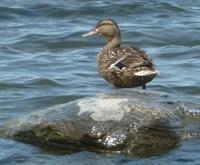Swimmer's Itch
Itchy skin? Been wading or swimming at the beach? You may be suffering from swimmer’s itch, a basically harmless but irritating allergic reaction caused by tiny aquatic worms who have mistaken you for a duck.

Biology of Swimmer's Itch
Swimmer’s itch or Schistosome dermatitis is a temporary skin infection acquired by bathers in lakes and rivers when they accidentally become involved in the life-cycle of a tiny aquatic worm (Schistosome spp). This worm is common in the small inland lakes in the Severn Sound watershed, such as Little Lake and Bass Lake, as well as in Severn Sound itself.
The adults are parasites in the blood vessels of aquatic birds, particularly waterfowl, and rodents. Following mating, the females lay eggs in the intestinal veins of the host. The eggs migrate into the intestines and are passed into the water with the droppings. In the water, the eggs hatch into tiny free-swimming larvae called miracidia. In order to survive, the miracidia must find and penetrate the tissues of certain species of freshwater snails. Here, further development takes place and the worms emerge as cercariae, minute, fork-tailed, colourless, free-swimming larvae that are barely visible to the naked eye. During warm weather, the cercariae emerge from the snails and drift about in the water searching for suitable hosts, such as waterfowl, in which to complete their life cycle.
The normal cycle is broken if the cercariae penetrate the skin of human swimmers. As humans are unsuitable hosts, the parasites quickly die in the skin; however, they may cause the allergic reaction known as swimmer’s itch.

Cercariae emerge from their snail hosts in the greatest numbers during the warmest weather, when most swimming is done. Hot spells speed up development and increase the number of cercariae that are liberated from the snail hosts. The first cases of swimmer’s itch generally occur in late June and reach a peak in late July. Although active swimming by the cercariae is quite limited, they can be carried considerable distances by water currents and are often concentrated in shallow shoreline waters when onshore winds are prevalent. High incidences of swimmer’s itch at certain beaches can be explained by the abundance of host snail species coupled with the presence of waterfowl. It is not related to water quality.
Symptoms of swimmer's itch
Shortly after leaving the water, the swimmer may experience a tingling sensation and red spots will appear at the sites of penetration. Several hours later, the victim will feel a distinct itching and the red spots will enlarge to form separate bumps up to 0.5 cm (one quarter inch) in diameter. The degree of reaction varies with the sensitivity of the individual and the severity of the infestation. Swimmer’s itch will not spread to other parts of the body, in contrast with other common skin afflictions such as poison ivy, and is associated only with swimming or wading in certain natural waters.
Prevention and treatment of swimmer's itch
- Avoid wading or swimming in areas where fresh water snails are plentiful or swimmer’s itch has been identified.
- Since the cercariae do not penetrate the skin until the water evaporates, it may help to rub down briskly with a coarse towel immediately after coming out of the water.
- Treating the itching with antihistamines or with calamine lotion may help.
- If a secondary infection develops through scratching, see your doctor.

